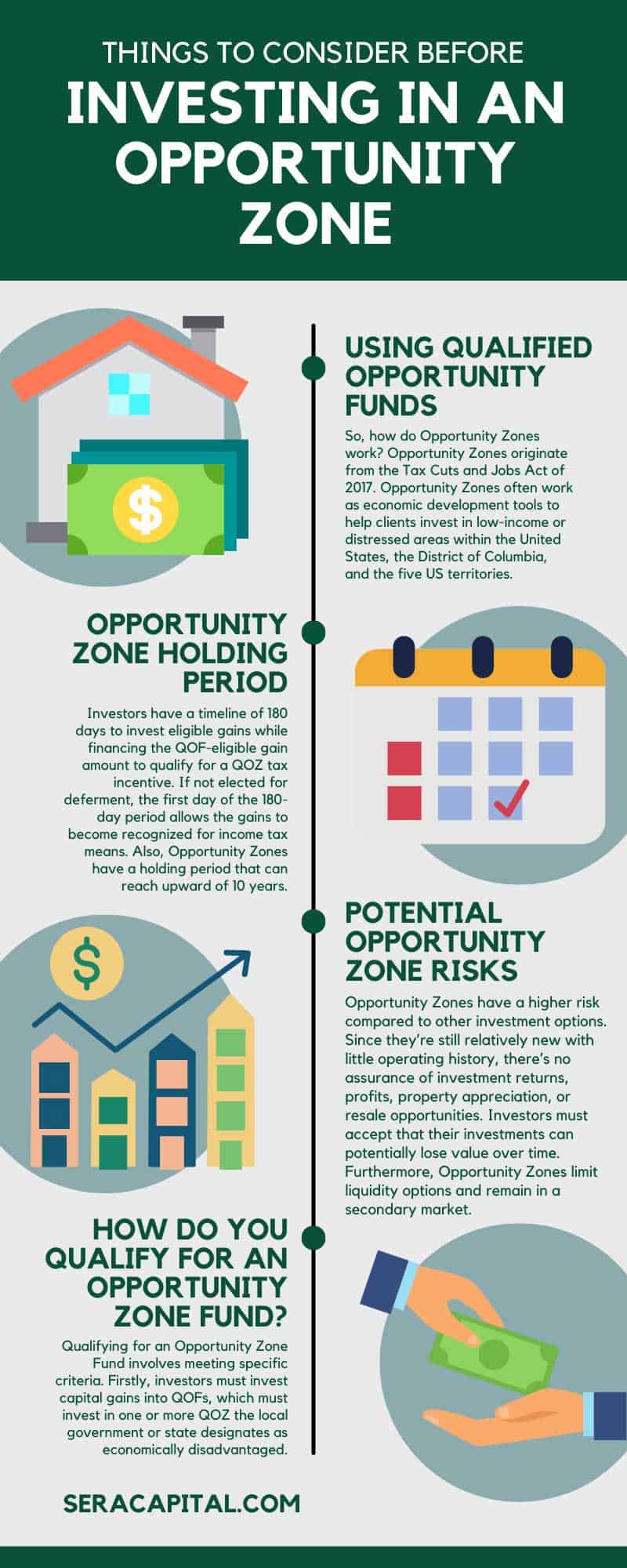Things To Consider Before Investing in an Opportunity Zone

Carl E. Sera, CMT
April 25, 2023
Opportunity Zones often represent economically compromised communities that desperately need revitalization and investment. Opportunity Zone Funds are private or public partnerships, allowing the government to incentivize investors to sell highly appreciated assets. These zones and funds originate from the 2017 Tax Cuts and Jobs Act to help boost economic growth and create job opportunities via incentivized investment through these low-income regions.
But how do Opportunity Zones operate, and how do they benefit the investor? Let’s review a couple of considerations before investing in an Opportunity Zone. Investors will also learn about the differences between QOZs and DSTs, potential risks, common questions, and the holding period for Opportunity Zones.
Understanding Opportunity Zones
So, how do Opportunity Zones work? As we previously mentioned, Opportunity Zones originate from the Tax Cuts and Jobs Act of 2017. Opportunity Zones often work as economic development tools to help clients invest in low-income or distressed areas within the United States, the District of Columbia, and the five US territories.
Furthermore, an Opportunity Zone Fund helps investors defer capital gains taxes from their investments until December 31st, 2026, or until their inclusion event. The US Department of Treasury provides certified locations to find Qualified Opportunity Zones (QOZs).
Using Qualified Opportunity Funds
Investing in a QOZ requires the use of a Qualified Opportunity Fund (QOF). Qualified Opportunity Funds are investment vehicles a corporation or partnership organizes, holding at least 90 percent of assets in QOZ properties.
A limited liability company (LLC) may qualify as a QOF if it chooses treatment as a corporation or a partnership for federal income tax purposes and organizes itself for investment in QOZ properties. Also, according to IRS guidelines, a QOF must double within 30 months to qualify for tax benefits. Furthermore, it must provide proof of substantial improvement in its assets.
Delaware Statutory Trusts vs. Qualified Opportunity Funds
Many investors consider QOFs and Delaware Statutory Trusts (DSTs) for real estate investments with tax benefits. However, while DSTs and QOFs allow investors to defer their capital gains taxes, they differ considerably.
Firstly, DSTs in the 1031 exchange don’t require location-specific requirements but have criteria for replacement properties to qualify for eligibility. Meanwhile, QOFs require investing in IRS-approved Opportunity Zones. Furthermore, Opportunity Zone investments come with many benefits, including providing broader investment criteria and sizable tax advantages. Lastly, they help benefit underdeveloped communities with economic struggles.
Opportunity Zone Holding Period
Investors have a timeline of 180 days to invest eligible gains while financing the QOF-eligible gain amount to qualify for a QOZ tax incentive. If not elected for deferment, the first day of the 180-day period allows the gains to become recognized for income tax means. Also, Opportunity Zones have a holding period that can reach upward of 10 years.
If investors hold their Opportunity Zone investment for five years, it can increase deferred gains by 10 percent. After seven holding years, deferred gains increase by an additional five percent. Once investors reach the 10-year holding mark, it permanently excludes gains resulting from exchanging or selling. This can occur if investors elect to increase their QOZ investment basis to market value.
Potential Opportunity Zone Risks
The purpose of Opportunity Zones is to help promote investments in underdeveloped markets. However, because they remain a relatively new concept, investors should know about potential Opportunity Zones risks before investing.
Firstly, Opportunity Zones are long-term investments, and investors must meet their contractual obligations and provide capital. Failure to follow obligations could result in adverse consequences, including interest forfeiture.
Secondly, Opportunity Zones have a higher risk compared to other investment options. Since they’re still relatively new with little operating history, there’s no assurance of investment returns, profits, property appreciation, or resale opportunities. Investors must accept that their investments can potentially lose value over time. Furthermore, Opportunity Zones limit liquidity options and remain in a secondary market.
Finally, Opportunity Zone Funds remain leveraged, increasing investment exposure to economic downturns, interest rates, and asset condition deterioration.
Common Opportunity Zone Questions
Despite the risks, Opportunity Zones have much to offer in helping underdeveloped communities while increasing assets. But if you’re interested in this investment opportunity, you might still have some questions. Let’s go over some common questions investors should know the answers to about Opportunity Zone Funds.
What Is the Timeline for Opportunity Fund Zones?
Depending on the specific fund, the timeline of an Opportunity Zone Fund can vary. However, investors must commit themselves to a fund for at least 10 years before receiving eligibility for tax benefits. This includes a commitment to keeping funds invested in the Opportunity Zone or capital gains reinvestment in QOZs.
Investors may also have requirements to invest specific capital amounts upfront, then make additional investments periodically. Overall, the Opportunity Zone Fund investment timeline is crucial when evaluating investment benefits, as you must have the time and resources to do so.
How Do OZ Funds Create Tax Benefits?
As investors place capital gains into Opportunity Zone Funds, they can defer and reduce federal gains taxes and obtain tax benefits. A significant benefit of Opportunity Zones is capital gains tax deferral. This allows investors to defer tax payments until December 31st, 2026, or until they sell the fund.
Furthermore, QOFs provide other tax benefits, such as excluding QOZ Business property depreciation and Unrelated Business Income Tax.
How Do You Qualify for an Opportunity Zone Fund?
Qualifying for an Opportunity Zone Fund involves meeting specific criteria. Firstly, investors must invest capital gains into QOFs, which must invest in one or more QOZ the local government or state designates as economically disadvantaged.
Additionally, you must be able to meet the 10-year holding time for QOZ investments. Finally, investors must follow the specific rules for taxation and timing. By following these rules, investors can benefit significantly from various tax incentives and receive potential returns on their investments.
When looking for an exit planning firm for 1031 exchanges, we at Sera Capital offer our services to those with highly appreciated assets. When 1031 exchanges aren’t in your best interest, our real estate opportunity fund services can help utilize tax-saving opportunities and attract return rates from the sale of an asset. These assets include real estate, collection, cryptocurrency, art, and more, as long as there’s capital gain to invest. If you have any questions about our Opportunity Zone services and real estate investing services, contact us today!

Categories
Strategize Your Success
